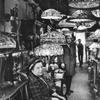PRIZED PHOTOGRAPHS AND SILKSCREEN PRINTS BY ANDY WARHOL HIGHLIGHT EXHIBITION AT GODWIN-TERNBACH MUSEUM SEPT. 11 - NOV. 1
- FLUSHING, New York
- /
- August 19, 2014

Recent gifts of photographs and silkscreen prints from the Andy Warhol Foundation highlight a new exhibition titled “Andy Warhol’s Photo-Aesthetic and Beyond,” on view at the Godwin-Ternbach Museum at Queens College from September 11 to November 1, 2014. The exhibition, which will include loans from other collections, explores Warhol’s use of photo silkscreen, Polaroid, silver gelatin prints, and black and white print media to create a “photo-aesthetic,” a hallmark style in the genre of Pop Art.
“By presenting images in different media side by side, the exhibition will allow viewers to move back and forth between moments of Warhol’s ‘art,’ ‘work,’ and ‘life’--inseparable parts of a fascinating whole,” says Amy Winter, Godwin-Ternbach Director.
The recently donated color silkscreens include portraits of the iconic American figures Muhammad Ali and Sitting Bull; “portraits” of two famous monuments, the Brooklyn Bridge and Cologne Cathedral; and Ladies and Gentlemen, one image from a series of portraits of New York City transvestites created by Warhol in 1975. These prints were made following Warhol’s usual formula: a Polaroid portrait of the sitter or image was silkscreened onto paper or canvas and then embellished with silkscreen ink in a bright array of nearly psychedelic colors. The gift enhances the Godwin-Ternbach’s already sizable collection of Warhol art, which includes the Campbell’s Soup and Electric Chair suites of photo-silkscreen prints.
“This show gives the public the rare opportunity to see a large compendium of Warhol works, including three complete series, and to understand how his use of photography revolutionized fine art,” notes Winter.
900x927.jpg)
In the planning stages since the Foundation’s first donation of photographs to the Godwin-Ternbach Museum in 2007, the exhibition examines how Warhol’s work countered photography’s realism and highlighted the impact of popular culture. It will show how Warhol transformed fine art following World War II from an elite, romantic practice producing singular, hand-painted works to an aesthetic for everyone that emphasized reproductions and the marketplace.
Appropriating the means and content of mass media, including celebrities, comic books, and advertising, Warhol utilized photo-mechanical reproductive methods, emphasizing the replica vs. the original work of art, often in a mock-serious or ironic tone. As noted by one critic, “a wealth of information about Warhol’s process and his interactions with his sitters is revealed in these images.”
Paired with this exhibition will be four large-scale digital photographs by Malaysian-born Chinese artist Chee Wang Ng, which pay homage to Warhol. In these works Ng visually employs tongue-in-cheek humor--for instance, juxtaposing Campbell’s Soup cans with bowls of rice, a classic Chinese image and metaphor. In doing this, he recontextualizes, challenges and reevaluates Chinese culture, exploring Chinese diaspora identity, a globally underrepresented but immense population, to raise awareness about the diversity of Chinese culture and transformation of its traditions. The public at large will also see Warhol from the fresh perspective of an Asian artist and comprehend the complexity of his work and its global influence.
Further information on “Andy Warhol’s Photo-Aesthetic and Beyond” can be found at the museum’s website: http://qc.cuny.edu/?id=5LF6 . An opening reception will be held on Thursday, September 18, from 6-8 pm. The public is cordially invited.














100x100_c.jpg)

